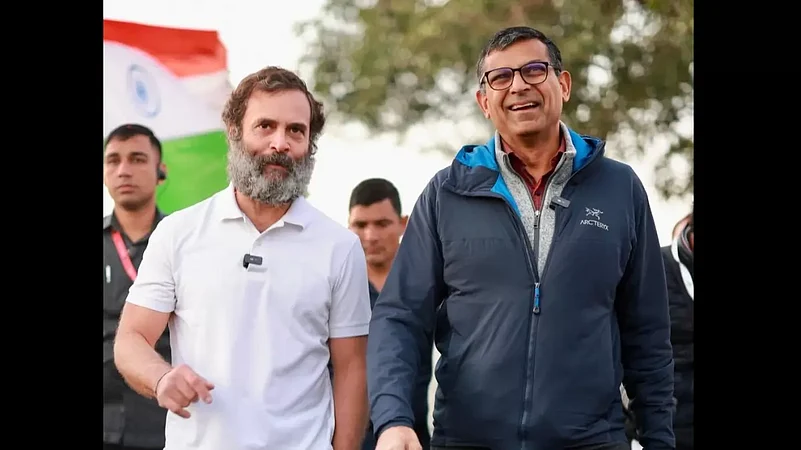Former Reserve Bank of India (RBI) Governor Raghuram Rajan joined the Rahul Gandhi-led Bharat Jodo Yatra on Wednesday, initiating a debate on whether economists like Rajan can take part in political rallies. The ruling party and some segments of media did not take the top economist’s presence at the yatra lightly. Bharatiya Janata Party’s (BJP’s) IT cell chief Amit Malviya even termed it a “coloured and opportunistic” involvement.
With recent developments, it is clear that Rajan’s presence around Opposition leaders has stirred talks on his likely ‘political’ future. People have already started discussing the possibility of the former central bank Governor taking the economist-to-statesman career trajectory like the former Prime Minister Manmohan Singh.
Advertisement
This is the not the first time that Rajan became a topic of interest for prime time newsroom debates and newspaper columns. Even before becoming the Chief Economic Advisor (CEA) to the second UPA government, and further taking over the governorship of RBI, Rajan had an impressive career in academia and policymaking. He has had impactful stints at prominent places like University of Chicago and the International Monetary Fund (IMF).
While his 2005 predictions about a looming “financial disaster” won him a lot of international acclaim in the aftermath of the 2008 global financial crisis, it was mainly his involvement in the Indian economy that made him a popular name within the country. In the past, the former IMF chief economist has voiced his opinions on not just economic affairs concerning India, but also on several social and political matters. However, if one is to go by his most effective work, his governorship of India’s central bank deserves detailed attention.
Advertisement
Raghuram Rajan’s Role In The Indian Economy
It was in November 2008 that the then Prime Minister Manmohan Singh handpicked Raghuram Rajan as an economic advisor to his office. Back then, a high-level government committee under Rajan submitted a report called A Hundred Small Steps, wherein it was suggested that the RBI narrow down its objective to having a low and stable inflation level before handling other issues like exchange rate and capital flows.
Eventually, in 2012, when the office of the CEA under the Ministry of Finance got vacant, Rajan was elevated to that post. He took over at a time when inflation and twin deficits were high while domestic production was very low. However, he did not have a long term in this position as he was re-assigned as the RBI Governor within just 13 months of serving as the CEA.
In the 3 years under Rajan, the RBI oversaw some critical moments in the Indian economy. When he took over the reins of the central bank, Indian rupee was under a lot of pressure. To save the rupee’s valuation, on his first day as the Governor, Rajan announced the ‘foreign exchange swap scheme.’ Through this measure, India was able to rein in $30 billion through FCNR-B (Foreign Currency Non-Resident - Bank) deposits. This helped the Indian rupee prop up its value and consequently decrease India’s import bill.
Inflation was yet another issue that was plaguing the Indian economy when Rajan was brought into the RBI. To combat this, he raised the benchmark interest rates twice within the first two months of his tenure. This was followed by another rate hike in early 2014. Through such measures, India was able to control its inflation. Under Rajan, India's inflation came down from 9.5 per cent to 5.3 per cent between August 2013 and August 2016.
Advertisement
To boost the infrastructure sector, the Rajan-led RBI implemented the ‘5 by 25’ scheme which extended the tenure of loans given to infrastructure and core industries. For the banking sector, Rajan initiated the Central Repository of Information on Large Credits (CRILC) in July 2014, which aggregated the data on Non-Performing Assets (NPAs).
This measure helped standardise the lending practices of small banks and assess the risky, large exposures that such banks had towards corporate accounts. This was especially important as a large number of NPAs were clogging the balance sheets of relatively smaller Indian banks.
Another important step in the banking sector that the RBI took under Rajan’s leadership was the 2015-16 Asset Quality Review (AQR). This out-of-turn inspection on bank books was aimed at better identification of NPAs and an overall clean-up of banks’ balance sheets. The eventual impact was that the banking sector took a big hit in terms of its profit books. Rajan’s ‘deep surgery’ measure resulted in the Indian banking sector’s bad loans jumping 80 per cent in FY16, according to RBI data.
Advertisement
However, the AQR came under fire from the Economic Survey 2021. It was pointed out that the move did not include any forced recapitalisation of the banks, which left them reeling under financial duress for quite a while. Additionally, many believe that the AQR failed to recognise the ever-greening of bad loans that took place in ways other than formal restructuring.
After Stepping Down
Rajan’s 3-year-long tenure at the helm of India’s central bank has had mixed reviews. However, the fact remains that he had an impactful time and he remains one of the few names who is remembered as an RBI chief even long after he stepped down.
Advertisement
Since then, Rajan has been a very vocal critic of some of the Modi regime’s economic policies. While some construe a political angle in his criticism, that has only ever been a speculation. Now, with his participation in Rahul Gandhi’s Bharat Jodo Yatra, the opinion that Raghuram Rajan is an economist with strong partisan leaning is only becoming louder.
Although the comparison between Raghuram Rajan and Manmohan Singh is still a stretch, the image of the former chatting with Rahul Gandhi on the state of Indian economy might just be a harbinger of things to come.















 Just one email a week
Just one email a week